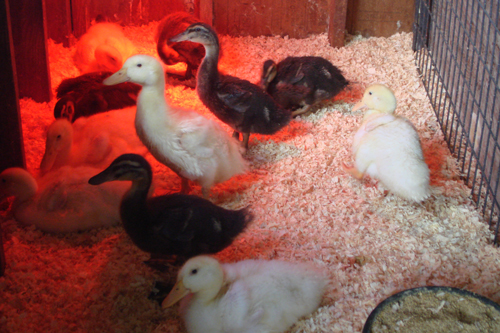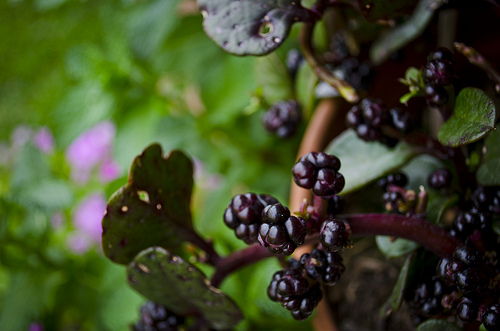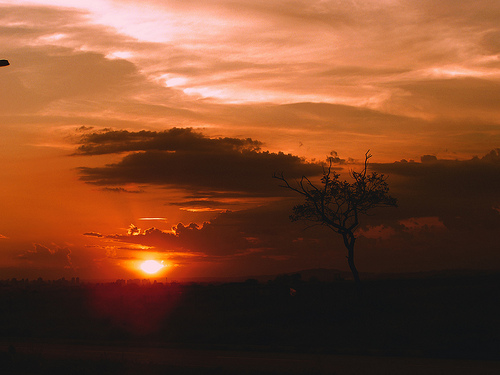Posts Tagged ‘Mash’
Best Ever Berry Jam
Within 5 miles of our house we have three U-pick operations and several Farmer’s Markets where we can find a good selection of seasonal berries. And, although there is nothing better than jumping in the car, combing fields for the freshest produce and ripping it from the soil, the place I like the best is my neighbor’s backyard.
We watch Fran and Joe’s place, feed the chickens and water the gardens when they are on vacation. Our payment…anything that’s ripe.
It was cloudy and a slight westerly breeze blew when Brianne and I walked down the street to check on things. As Brianne went about her chores, I headed for the berry patch. The huge, dark blackberries clung to their canes like gems. I filled my colander. I had a plan. That afternoon I would take these little gems and cook them slowly on the stove, filling the house with their sweet aroma. Mmmm.
Making any kind of Berry Jam is easy. All you really need is berries and sugar. You can use pectin (liquid or powder) if you like, but I prefer not to. I just fill a large pot with 9 cups of berries and 6 cups of sugar, turn the heat on and slowly bring to a boil, stirring occasionally, until all the sugar is dissolved. At this point I either mash the berries with a potato masher or lightly whirl them with an emersion blender, making sure to leave a bit of chunkiness. I continue cooking and stirring the jam rapidly until it reaches the gelling point. When the jam is gelled enough I remove it from the stove and ladle it into hot jars. The jars are dropped into the water bath canner for 15 minutes then set on a clean dry cloth to cool. When you hear the tell-tale POP of the lid, signaling the proper seal, you know you’ve done it right.
The whole process, from first wash of berries to the last lid POPPING takes less than an hour. And, for that you get enough berry goodness to remind you of summer all winter long. I made 9 pints of jam. That’s a lot of jam, folks! And, what a bargain, too. For the price of a few jars and lids, and free berries from friendly neighbors my pantry is stocked with something way better than Smuckers. Not a bad deal!
For detailed instructions, pick up a copy of the famous Ball Blue Book Guide to Preserving, at any hardware, farm store, book or discount store. It covers everything you need to know about canning and costs less than a case of jars. Enjoy!
![]() photo credit: Price Finder
photo credit: Price Finder
Accidental Education
I’ve come to realize that most of my education on the farm has been as much a case of learning by chance then by deliberate study. Or should I say we learn just by living. For certain, the learning we gain through experience or by doing sticks with us long after the classroom fades. I may not remember anything about my statistics class, but I will not forget what happened when I was dumb enough to walk through the corral with a bucket full of grain or store my feed bins too close to the sheep pens.
I’ve learned by chance, for example, that a good way to start pumpkin seeds is to let the pumpkins rot in place. As the bottom of the pumpkin decays away the seeds start to sprout inside the shell, protected by winter cold. In spring all I have to do is transplant the tiny plants into individual containers until they are ready to plant out in the pumpkin patch.
Seeds dropped by birds or blown in on the wind can nestle themselves into friable debris piles near the barn and come to sprout in the warm composting material until ready to plant.
Another accidental discovery took place this past fall after the lambs had been sent off to the butcher. We left the remaining hay in its normal place on the barn floor instead of using it for mulch or composting material. As the weeks and months went by I noticed the remaining hay bales kept settling down and spreading out more than it should be doing naturally. What the heck was going on? Read the rest of the story »
A Thrifty Thanksgiving
It’s November 2010, the elections are fresh in our minds and everywhere we go there are the reminders of the coming holiday season. But, the economy still looms heavy on our minds. Fears about jobs, price increases and shortages have us feeling uncertain about what this season will be like.
BUT – here on our little homestead we’re determined not to let this air of uncertainty affect our love of fall and one of the two biggest holidays of the calendar Thanksgiving. We have however decided to make this a budgeted holiday with plenty of memory making activities like free concerts, walks through the decorated areas of town with a mug full of warm apple cider and holiday programs.
So, how does one have a thrifty Thanksgiving dinner? By using what you have on hand, that’s how.
We’ll start a few days before Thanksgiving by thawing out a 9-1/2 pound roasting chicken from a batch we raised last year. I’ll make a few fresh loaves of bread (saving enough dough to make dinner rolls) with herbs from the garden baked in, as a base for our stuffing. When it’s cooled enough I’ll cube it and let it dry out.
On Wednesday I’ll prepare a brine of coarse salt, spices, herbs, apples and cider. The chicken will soak in the brining bucket, submerged in its flavorful concoction for 24-hours.
On Thanksgiving morning, once the animals are fed and morning chores complete, and the chicken is thoroughly rinsed and set out to come to room temperature, we’ll pack up our gear and head to our favorite hiking area. While most people are frantically trying to get their turkeys in the oven by mid-morning we’ll be trekking the hills breathing in fresh air and reveling in the colors of nature. Home by noon and with a light lunch of soup and grilled cheese sandwiches, on home baked bread, we’ll be fortified enough to put our energies into our evening meal.
Brianne will peel and cube homegrown potatoes for our cheesy herb infused mash, while my sister slices a newly harvested Butternut squash that will be baked with brown sugar, butter and spices. Greens will be washed and prepared for a wonderful fall mixed green, pecan, blue cheese and cranberry salad with Blueberry-Pomegranate dressing, all from ingredients in my pantry.
The stuffing, squash and dinner rolls will go into the oven and cook along with the bird.
Once the turkey – I mean chicken – is finished roasting I’ll whip up some gravy from the drippings and all will be laid out on a festive table as a grand feast.
The whole meal will be finished off with individual Harvest Pumpkin cakes, made from our own successful pumpkin patch, and topped with a cream cheese frosting and pecan halves.
There you have it, a wonderfully filling homegrown, homemade Thanksgiving feast.
For the rest of the evening we’ll settle into a roaring fire watching some of our favorite movies. I’ll take comfort in the fact that this years celebration was made mainly from ingredients we grew ourselves or already had one hand, with only a few items purchased at the Farmer’s Market for just a few dollars. I can now rest easy that what had caused me concern will turn out to be a wonderful and intimate celebration of the harvest.
That’s the perfect ending to a perfect day.
![]() photo credit: Alanna Kellogg
photo credit: Alanna Kellogg
The Sun Hangs Low
Daylight savings time has given this farm a special gift. The extra hours of daylight allows enough time to let the chickens out in the garden every evening. For a few brief hours they can play and run, scratch in the dirt and dig for bugs. Then before I head back into the house, I move them all back into the safety of their little coop. Most of the winter they’ve been stuck inside since heavy rains turned their outside run into a pond. But now the rains have subsided and the water has retreated into the soil. The flock can run out in the open again. And, you should see them go – running around, well, like chickens with their heads cut off – flapping their wings and squawking like mad.
So, while Brianne is working her show lambs, I walk over to the coop, grab a handful of scratch, unlatch the door and entice them out. It doesn’t take much, before they are happily pecking and scratching at dropped bits of grain and hay on the barn floor. When I first open the coop door, the smaller bantams are reluctant, but the Blue Cochin (Blue Boy) makes a beeline for freedom, followed by three Arucana hens. In the end, even the timid girls venture out. Eventually, they all make it into the wide open world. I follow behind moving them toward the garden and out of sight of the sheep. Not that the sheep will do any harm, it’s just that the chickens are a distraction while Brianne is working her lambs.
This weekend saw days in the 60’s and is slowly absorbing what’s left of the standing water in the garden. I’ve started turning garden beds, and getting my early season veggies in. Lettuces, peas, broccoli, onions… (you get the idea.) But there is so much to do outside right now; the garden is constantly in the back of my mind.
Yesterday was a hard core farm day. We spent most of the afternoon working outside. We had to clean out old bedding in the chicken coop and replace it with fresh and the sheep pen needed to be raked out too. We hauled 50lb bags of sheep feed and lay mash over our shoulders. We moved the rack of firewood, that stands near the back door for easy access during rainstorms, to it’s off season location on the south side of the house. And when we weren’t doing intense physical labor we were tending to the early blooming flowers. We also collected eggs, checked on overall bird health and trimmed a few toenails and spurs. The lambs’ hooves were also trimmed and checked for signs of foot rot (a common condition in wet weather when there is standing water). We even managed to clean out the rabbit hutch and move all that glorious, nutrient rich manure to the compost pile. Needless to say, we came in from our long day dirty, sore and tired, but happy that we were able to accomplish so much. A long hot bath, a warm home cooked meal and good book enjoyed in a quiet room set us back on tract though.
It was all worth it.
I’ve got a pot of tea on now, and listening to the chicks in their box house beside me while I type is like a sweet symphony.
In a few moments I’ll go out to feed the dogs and refill the chicks’ water and food. But, for now, I think the dogs and I are going to sit here and enjoy some music and Earl Gray tea. It’s not like they haven’t been through this before. Enjoy your evening folks.







Recent comments
Aenean nonummy hendrerit mauris. Phasellus porta.